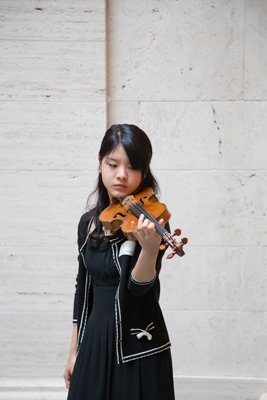Three generations of the Sperry family arrived right on time for the Harvard Art Museums’ opening celebration on Sunday, November 16. As they walked in promptly at 10am, Kevin Sperry, his mother Rose, wife Cricket, and daughter Erin were treated to the bright sounds of trumpets, played by students in the Harvard University Band, and the simultaneous ringing of the Memorial Church bells—at the exact moment the museums officially opened to the public.
“I’m here for the experience of the opening; I love the museums,” said Kevin Sperry, a Cambridge native, sitting in the Calderwood Courtyard. “So far, it feels the same, but it’s airier. I like the lightness of the space. It feels more open.”
Both Kevin and Rose Sperry grew up in Cambridge and had visited the Fogg Museum since childhood. Kevin recalled many happy memories there, including stopping in the building on his way to and from high school, and bringing his daughters to the Fogg when they were young. The opening of the new Harvard Art Museums, which now comprise the Fogg, Busch-Reisinger, and Arthur M. Sackler Museums, was therefore meaningful to the whole family—and so significant that Kevin planned his birthday (coincidentally, November 16) around it. “We’ve been waiting for this moment for six years,” said Rose.
People of all ages, and with a range of connections to the museums, came from near and far to tour the renovated building. About 3,000 members of the public had reserved free tickets for the day, which had special extended hours of 10am to 10pm.
A short morning program in the Calderwood Courtyard included remarks from Thomas W. Lentz, the Elizabeth and John Moors Cabot Director of the Harvard Art Museums; Alan Garber, provost of Harvard University; and Richard C. Rossi, city manager for the City of Cambridge. “Here in this courtyard, where you are sitting right now, we will create a crossroads for our community,” Garber told the crowd. Lentz encouraged visitors to “linger, to wander aimlessly, happily.”
Interspersed between the welcoming words were performances of poetry and music, representing the wider realm of the arts. The ceremony opened with the New England Conservatory of Music’s Brass Quintet and Percussion Ensemble performing an original composition by Harvard professor Jerold S. Kayden. David Nee, a graduate student in the Department of English, read Tomas Tranströmer’s poem “Vermeer,” which concludes, “I am not empty, I am open.” Sumire Hirotsuru ’16 delivered a stirring performance of Johann Sebastian Bach’s Partita for solo violin No. 3 in E Major, BMW 1006: Gavotte en Rondeau.
The rest of the day visitors were free to explore all facets of the museums—from Menschel Hall, which showed a looped time-lapse video of the building’s construction over the past six years, to the special exhibition Mark Rothko’s Harvard Murals. There were also multiple musical performances in the courtyard, including Harvard’s Din and Tonics a cappella group and Brattle Street Chamber Players.
For Sirgay Sanger, a ’56 Harvard College and ’60 Harvard Medical School graduate, the vast art collections were the major draw. Sanger was a fine arts and biology major as an undergraduate, and spent a great deal of time at the Fogg at the time. In fact, he said, “The Fogg was what got me into med school; recommendations from my professors at the Fogg were essential.” He and his wife had traveled from New York City the day before so that they could be among the museums’ very first guests.
Leisurely admiring Italian and Indian works in the European and South Asian galleries, Sanger said he thought the new gallery spaces “are wonderful; they flow so well. And they are more relaxed.”
In the Lightbox Gallery three floors above, Chenling Wang was also marveling at the new spaces—namely, the Straus Center for Conservation and Technical Studies, which is visible through the glass walls on Levels 4 and 5. “It’s stunning,” she said, “all the details. This is just magnificent.”
An interior designer who has lived in Cambridge for 13 years, Wang said she walks by the building frequently, and had been “dying to see what’s inside. I don’t think I’ve ever been inside a Renzo Piano building,” she said, referring to the Pritzker Prize–winning architect who designed the new museums. She already had plans to return, with a date to meet a friend at the museums later in the week.
A few feet away, Robert Murrell and his son, Jahi, were peering down to the courtyard below, where families pushed strollers, curators chatted with visitors, and cafe patrons sipped coffee. A lifelong Cambridge resident, Robert said that he too had been waiting for this day “with bated breath.”
And his impression so far? “Yeah,” he said, laughing. “It definitely takes your breath away.”





